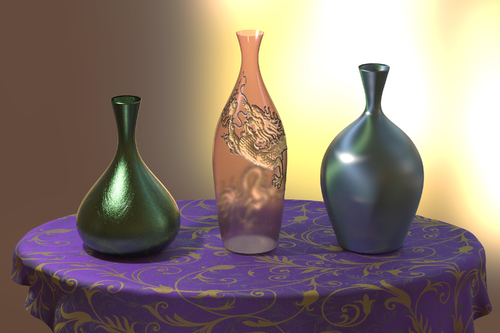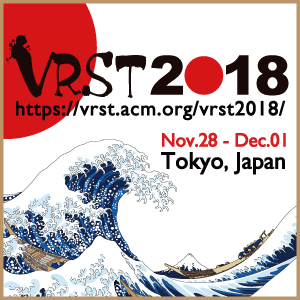-
 Full Conference Pass (FC)
Full Conference Pass (FC)
-
 Full Conference One-Day Pass (1D)
Full Conference One-Day Pass (1D)
Date: Wednesday, December 5th
Time: 9:00am - 10:45am
Venue: Hall D5 (5F, D Block)
Session Chair(s): Wenzel Jakob, École Polytechnique Fédérale de Lausanne,
Practical Multiple Scattering for Rough Surfaces
Abstract: Microfacet theory concisely models light transport over rough surfaces. Specular reflection is the result of single mirror reflections on each facet, while exact computation of multiple scattering is either neglected, or modeled using costly importance sampling techniques. Practical but accurate simulation of multiple scattering in microfacet theory thus remains an open challenge. In this work, we revisit the traditional V-groove cavity model and derive an analytical, cost-effective solution for multiple scattering in rough surfaces. Our kaleidoscopic model is made up of both real and virtual V-grooves, and allows us to calculate higher-order scattering in the microfacets in an analytical fashion. We then extend our model to include nonsymmetric grooves, allowing for additional degrees of freedom on the surface geometry, improving multiple reflections at grazing angles with backward compatibility to traditional normal distribution functions. We validate the accuracy of our model against ground-truth Monte Carlo simulations, and demonstrate its flexibility on anisotropic and textured materials. Our model is analytical, does not introduce significant cost and variance, can be seamless integrated in any rendering engine, preserves reciprocity and energy conservation, and is suitable for bidirectional methods.
Authors/Presenter(s): Joo Ho Lee, KAIST, South Korea
Adrian Jarabo, Universidad de Zaragoza - I3A, Spain
Daniel S. Jeon, KAIST, South Korea
Diego Gutierrez, Universidad de Zaragoza - I3A, Spain
Min H. Kim, KAIST, South Korea

Multiple Scattering from Distributions of Specular V-Grooves
Abstract: Microfacet-based reflection models are widely used to model light reflections from rough surfaces. However, a major current limitation of these models is that they only account for single scattering. In this paper, we present an analytical BRDF for a distribution of specular v-grooves that supports multiple scattering. Using the fact that the number of reflections inside a specular v-groove is bounded and analytically computable, we develop closed form solutions for our multiple scattering BRDF and its probability density function (PDF). We also present a method for importance sampling the BRDF. As a result, our BRDF can be easily integrated into real-time renderers and path-tracing based renderers like PBRT. Our model is reciprocal, energy preserving and can be used with any microfacet distribution function. It supports anisotropy, spatially varying roughness and the Fresnel Effect. The images produced using our model have a pleasing appearance compared to traditional single-scattering models.
Authors/Presenter(s): Feng Xie, Stanford University, United States of America
Patrick Hanrahan, Stanford University, United States of America
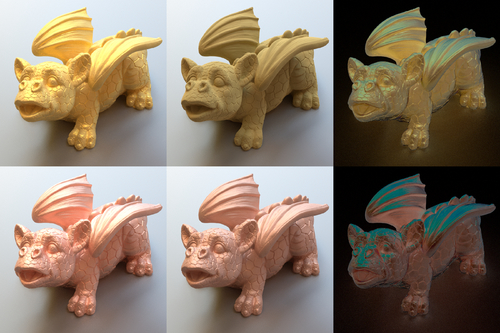
Scalable Appearance Filtering for Complex Lighting Effects
Abstract: Realistic rendering with materials that exhibit high-frequency spatial variation remains a challenge, as eliminating spatial and temporal aliasing requires prohibitively high sampling rates. Recent work has made the problem more tractable, however existing methods remain prohibitively expensive when using large environmental lights and/or (correctly filtered) global illumination. We present an appearance model with explicit high-frequency micro-normal variation, and a filtering approach that scales to multi-dimensional shading integrals. By combining a novel and compact half-vector histogram scheme with a directional basis expansion, we accurately compute the integral of filtered high-frequency reflectance over large lights with angularly varying emission. Our approach is scalable, rendering images indistinguishable from ground truth at over $\mathbf{10\times}$ the speed of the state-of-the-art and with only $\mathbf{15\%}$ the memory footprint. When filtering appearance with global illumination, we outperform the state-of-the-art by $\sim\! \mathbf{30\times}$.
Authors/Presenter(s): Luis E. Gamboa, Université de Montréal, Canada
Jean-Philippe Guertin, Université de Montréal, Canada
Derek Nowrouzezahrai, McGill University, Canada
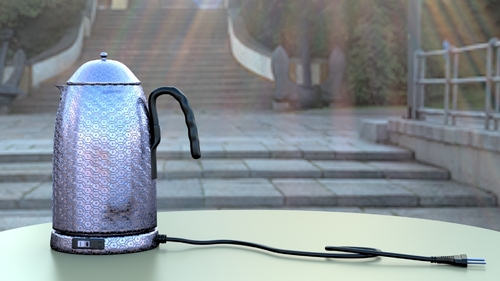
Geometry-Aware Metropolis Light Transport
Abstract: Markov chain Monte Carlo (MCMC) rendering utilizes a sequence of correlated path samples which is obtained by iteratively mutating the current state to the next. The efficiency of MCMC rendering depends on how well the mutation strategy is designed to adapt to the local structure of the state space. We present a novel MCMC rendering method that automatically adapts the step sizes of the mutations to the geometry of the rendered scene. Our geometry-aware path space perturbation largely avoids tentative samples with zero contribution due to occlusion. Our method limits the mutation step size by estimating the maximum opening angle of a cone, centered around a segment of a light transport path, where no geometry obstructs visibility. This geometry-aware mutation increases the acceptance rates, while not degrading the sampling quality. As this cone estimation introduces a considerable overhead if done naively, to make our approach efficient, we discuss and analyze fast approximate methods for cone angle estimation which utilize the acceleration structure already present for the ray-geometry intersection. Our new approach, integrated into the framework of Metropolis light transport, can achieve results with lower error and less artifact in equal time compared to current path space mutation techniques.
Authors/Presenter(s): Hisanari Otsu, Karlsruhe Institute of Technology, Germany
Johannes Hanika, Karlsruhe Institute of Technology, Germany
Toshiya Hachisuka, The University of Tokyo, Japan
Carsten Dachsbacher, Karlsruhe Institute of Technology, Germany
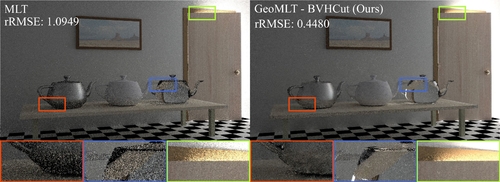
Position-Free Monte Carlo Simulation for Arbitrary Layered BSDFs
Abstract: Real-world materials are often layered: metallic paints, biological tissues, and many more. Variation in the interface and volumetric scattering properties of the layers leads to a rich diversity of material appearances from anisotropic highlights to complex textures and relief patterns. However, simulating light-layer interactions is a challenging problem. Past analytical or numerical solutions either introduce several approximations and limitations, or rely on expensive operations on discretized BSDFs, preventing the ability to freely vary the layer properties spatially. We introduce a new unbiased layered BSDF model based on Monte Carlo simulation, whose only limitation is the layer assumption itself. Our novel position-free path formulation is fundamentally more powerful at constructing light transport paths than generic light transport algorithms applied to the special case of flat layers, since it is based on a product of solid angle instead of area measures, so does not contain the high-variance geometry terms needed in the standard formulation. We introduce two techniques for sampling the position-free path integral, a forward path tracer with next-event estimation and a full bidirectional estimator. We show a number of examples, featuring multiple layers with surface and volumetric scattering, surface and phase function anisotropy, and spatial variation in all parameters.
Authors/Presenter(s): Yu Guo, University of California, Irvine, United States of America
Milos Hasan, Autodesk, United States of America
Shuang Zhao, University of California, Irvine, United States of America
